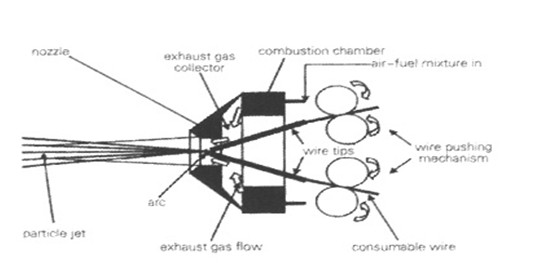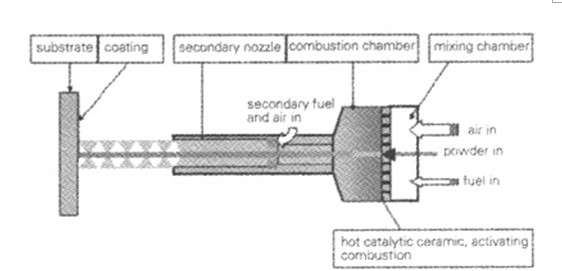

current position:Information and data>Process principle of thermal spraying
flame spray
As a new surface protection and surface strengthening process, flame spraying technology has developed rapidly in the past 20 years and has become a very active branch in the field of metal surface engineering. Flame spraying is the use of flammable gases such as acetylene, propane and oxygen combustion flame as a heat source to heat the spray material to a molten or nearly molten state, and auxiliary gases such as nitrogen or compressed air are sprayed onto the surface of the substrate to form a coating [4] .
The basic characteristics of flame spraying technology are: ①General metal and non-metallic substrates can be sprayed, and the shape and size of the substrates are usually not limited, but small holes cannot be sprayed at present; ②Coating materials are wide, metals, alloys, ceramics , composite materials can be coating materials, which can make the surface have various properties, such as corrosion resistance, wear resistance; high temperature resistance, heat insulation, etc.: ③ The porous structure of the coating has oil storage, lubrication and friction reduction properties, and contains hard The macro hardness of the sprayed layer of the quality phase can reach 450HB, and the sprayed layer can reach 65HRC; ④ The flame spraying has little effect on the substrate, the heating temperature of the surface of the substrate is 200-250 °C, and the overall temperature is about 70-80 °C, so the deformation of the substrate is small. The material organization does not change.
Disadvantages of flame spraying technology: ① The bonding strength between the spray coating and the substrate is low, and it cannot withstand alternating loads and impact loads; ② The surface preparation requirements of the substrate are high; ③ The flame spraying process is affected by various conditions, and there is no effective detection method for the coating quality. .
On the basis of supersonic flame spraying, American Verstak A and Baranovski V have successively developed HVAF Arc and AC-HVAF. HVAF-Arc is a new technology integrating conventional arc spraying and supersonic flame spraying. The working principle is as follows. The supersonic airflow generated by the combustion of the fuel and air mixture is used to atomize the particles melted by the arc and accelerate the particles, so that the molten high-speed particles are sprayed onto the surface of the substrate to form a dense coating. By controlling the ratio of fuel to air, using excess fuel can prevent particles from being oxidized during flight and improve the quality of the coating [5].

Figure 1 Schematic diagram of the working principle of HVAF Arc
AC-HVAF (Activated Combustion HVAF) spray gun consists of main combustion chamber and secondary combustion chamber. The main combustion chamber includes a mixing chamber, a reaction combustion chamber, an inner nozzle and a powder feeding nozzle; the secondary combustion chamber is mainly composed of an outer nozzle, secondary fuel and compressed air. The spray powder is fed axially into the combustion chamber and nozzle for heating and acceleration. Its working principle is shown in Figure 2
AC-HAVF was developed for the preparation of high-density, oxidation-free metal and metal carbide coatings, which are characterized by the fact that the particles are heated but not melted during the spraying process, and the sprayed particles have a high speed, the prepared coating It has strong wear resistance, low residual stress and high opportunity efficiency.

Hot information

